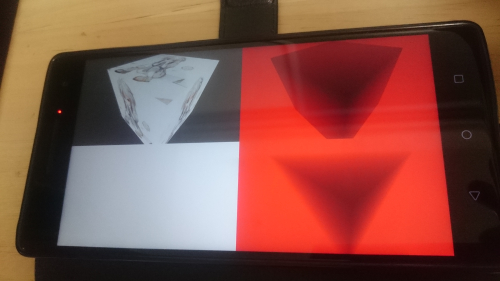オブジェクトのエッジを強調したり、モデルベースの画像処理を行いたいときなどは、見ているシーンの深度画像が必要になります。(これは本当)
OpenCV に現在フレームの深度画像を渡したいときは float 配列としてカメラからのZ距離が得られると文句はないのです。
この記事ではその float 配列の取得方法を動作確認込みで示します。

Unity で深度画像を得る方法をいくつか存じておりますが、私が知る中で最速な方法を示したいと思います。
前回、前々回と触ってきた Compute Shader を使います。(以下の方法が具体的にイメージできない人は読み返してね)
Compute Shader を新規作成したら、次のコードを記述します。
// Each #kernel tells which function to compile; you can have many kernels #pragma kernel CSMain float n_f; float f; Texture2D<float> _zBuffer; RWTexture2D<float> _cameraZ; [numthreads(8,8,1)] void CSMain (uint3 id : SV_DispatchThreadID) { #if SHADER_API_GLES3 // for Android _cameraZ[id.xy] = 1.0f / (n_f * (1.0f - _zBuffer[id.xy]) + f); #else // for Windows _cameraZ[id.xy] = 1.0f / (n_f * _zBuffer[id.xy] + f); #endif }
単なるシェーダーではなく Compute Shader であるため UNITY_REVERSED_Z による判定が行えません。
Android では UNITY_REVERSED_Z ではなかったので泣く泣く SHADER_API_GLES3 でコードを変更しています。
この Compute Shader を使うスクリプトは次の通り
using System.Collections; using System.Collections.Generic; using UnityEngine; [RequireComponent(typeof(Camera))] public class VirtualCameraBehaviour : MonoBehaviour { private int width; private int height; Camera _virtualCamera = null; RenderTexture _color = null; RenderTexture _zBuffer = null; public RenderTexture _cameraZ = null; public ComputeShader Depth; public GameObject uiResult0; public GameObject uiResult1; public GameObject uiResult2; void Start () { width = Screen.width / 2; height = Screen.height / 2; _virtualCamera = GetComponent<Camera>(); _color = new RenderTexture(width, height, 0, RenderTextureFormat.ARGB32); _zBuffer = new RenderTexture(width, height, 32, RenderTextureFormat.Depth); _virtualCamera.SetTargetBuffers(_color.colorBuffer, _zBuffer.depthBuffer); _cameraZ = new RenderTexture(width, height, 0, RenderTextureFormat.RFloat); _cameraZ.enableRandomWrite = true; _cameraZ.Create(); float n_inv = 1.0f / _virtualCamera.nearClipPlane; float f_inv = 1.0f / _virtualCamera.farClipPlane; Depth.SetFloat("n_f", n_inv - f_inv); Depth.SetFloat("f", f_inv); Depth.SetTexture(0, "_zBuffer", _zBuffer); Depth.SetTexture(0, "_cameraZ", _cameraZ); uiResult0.GetComponent<UnityEngine.UI.RawImage>().texture = _color; uiResult1.GetComponent<UnityEngine.UI.RawImage>().texture = _cameraZ; uiResult2.GetComponent<UnityEngine.UI.RawImage>().texture = _zBuffer; } void Update () { } private void OnPostRender() { Depth.Dispatch(0, _zBuffer.width / 8, _zBuffer.height / 8, 1); } }
オフスクリーンレンダリングで、解像度を指定して VirtualCamera 画像を作り、そのカラー画像や深度画像を float 32bit 深度 1チャンネル画像として取得しています。
CPU 側で float 配列を手に入れたい場合は次の一工夫を加えて完了です。
// Each #kernel tells which function to compile; you can have many kernels #pragma kernel CSMain float n_f; float f; int width; Texture2D<float> _zBuffer; RWTexture2D<float> _cameraZ; // for float Array RWStructuredBuffer<float> _zArray; [numthreads(8,8,1)] void CSMain (uint3 id : SV_DispatchThreadID) { #if SHADER_API_GLES3 // insted of UNITY_REVERSED_Z // for Android _cameraZ[id.xy] = 1.0f / (n_f * (1.0f - _zBuffer[id.xy]) + f); #else // for Windows _cameraZ[id.xy] = 1.0f / (n_f * _zBuffer[id.xy] + f); #endif _zArray[id.x + id.y * width] = _cameraZ[id.xy]; }
以下の対応で CPU 側の float 配列に深度画像の画素値が得られることを確認しました。
これで OpenCV にこのデータを使ってもらうことにより、さまざまなモデルベース処理が行えるという夢が広がります。
using System.Collections; using System.Collections.Generic; using UnityEngine; [RequireComponent(typeof(Camera))] public class VirtualCameraBehaviour : MonoBehaviour { private int width; private int height; Camera _virtualCamera = null; RenderTexture _color = null; RenderTexture _zBuffer = null; public RenderTexture _cameraZ = null; public ComputeShader Depth; ComputeBuffer _zArray; float[] _zArrayData; public GameObject uiResult0; public GameObject uiResult1; public GameObject uiResult2; void Start () { width = Screen.width / 2; height = Screen.height / 2; _virtualCamera = GetComponent<Camera>(); _color = new RenderTexture(width, height, 0, RenderTextureFormat.ARGB32); _zBuffer = new RenderTexture(width, height, 32, RenderTextureFormat.Depth); _virtualCamera.SetTargetBuffers(_color.colorBuffer, _zBuffer.depthBuffer); _cameraZ = new RenderTexture(width, height, 0, RenderTextureFormat.RFloat); _cameraZ.enableRandomWrite = true; _cameraZ.Create(); float n_inv = 1.0f / _virtualCamera.nearClipPlane; float f_inv = 1.0f / _virtualCamera.farClipPlane; Depth.SetFloat("n_f", n_inv - f_inv); Depth.SetFloat("f", f_inv); Depth.SetTexture(0, "_zBuffer", _zBuffer); Depth.SetTexture(0, "_cameraZ", _cameraZ); _zArrayData = new float[width * height]; _zArray = new ComputeBuffer(_zArrayData.Length, sizeof(float)); Depth.SetBuffer(0, "_zArray", _zArray); Depth.SetInt("width", width); uiResult0.GetComponent<UnityEngine.UI.RawImage>().texture = _color; uiResult1.GetComponent<UnityEngine.UI.RawImage>().texture = _cameraZ; uiResult2.GetComponent<UnityEngine.UI.RawImage>().texture = _zBuffer; } void Update () { } private void OnPostRender() { Depth.Dispatch(0, _zBuffer.width / 8, _zBuffer.height / 8, 1); _zArray.GetData(_zArrayData); float av = 0; for (int i = 0; i < _zArrayData.Length; i++) { av += _zArrayData[i]; } av /= _zArrayData.Length; Debug.Log("average z = " + av.ToString("0.0000")); } }